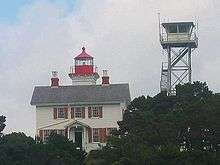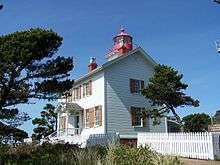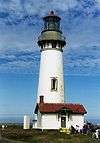Yaquina Bay Light
 Yaquina Bay Light | |
 | |
| Location | Yaquina Bay State Recreation Site |
|---|---|
| Coordinates | 44°37′27″N 124°03′46″W / 44.62415°N 124.06290°WCoordinates: 44°37′27″N 124°03′46″W / 44.62415°N 124.06290°W |
| Year first lit | 1871 |
| Deactivated | 1874–1996 |
| Foundation | Natural/emplaced |
| Construction | Wood |
| Tower shape | Square |
| Height | 51 feet (16 m) |
| Original lens | Fifth order Fresnel lens (original)/250MM (replacement) |
| Characteristic | |
|
Old Yaquina Bay Lighthouse | |
| Area | 2.3 acres (0.93 ha) |
| Built | 1871 |
| NRHP Reference # | 74001692[1] |
| Added to NRHP | 1970 |
The Yaquina Bay Light is a lighthouse built in 1871 soon after the founding of the city of Newport, Oregon, United States. It is located on the north side of Yaquina Bay, the most populated port between Puget Sound and San Francisco at the time.[2]
History

The Yaquina Bay Light was built by Ben Simpson and first lit on November 3, 1871.[2] It was active for only three years due to the establishment of the Yaquina Head Light in 1873, located 3 miles (4.8 km) north of Yaquina Bay. The bay lighthouse was decommissioned on October 1, 1874, because the Yaquina Head Light made it obsolete. The fifth order Fresnel lens was moved to the Yerba Buena Light for its opening in 1875.[2]
The U.S. Army Corps of Engineers used the lighthouse from 1888 to 1896 as a living quarters while it built the North and South Jetties at the mouth of Yaquina Bay. The United States Coast Guard later used the lighthouse as lookout and living quarters from 1906 to 1915, before moving to their more central quarters just above the busy Newport bayfront. During this period, the Coast Guard also built the eight-story steel observation tower that continues to stand next to the original lighthouse.
In 1934, the Oregon State Highway Division bought the property around the lighthouse for a state park. The park site included the lighthouse, coast guard observation tower, and acres of forested bluff, ocean dunes and beaches.
In 1946, the lighthouse was scheduled for demolition, which led to the formation of the Lincoln County Historical Society to save the lighthouse. They raised money for three years, but were unable to save it. By 1951, demolition was again scheduled. Recently moved from Ohio, L. E. Warford arranged for it to be recognized as a historical site supervised by the historical society. It served as a county museum for 18 years.[2]
It was listed by the National Register of Historic Places in 1970[1] and restored under the Historic Preservation Act in 1974, at which time ownership was transferred to the Oregon Parks and Recreation Department.[2]
The light was re-lit on December 7, 1996, with "a 9.8-inch (250 mm) modern optic on loan from lighthouse historian James A. Gibbs."[2] The light is a privately maintained navigational aid belonging to the U.S. Coast Guard. It displays "a fixed white light visible for six miles,"[2] and it is open for public viewing.[2]
The Yaquina Bay structure is the only existing lighthouse in the state in which the living quarters are housed in the same building as the light.[3] Only a few of this type were built on the entire Pacific coast.
The building is reputed to be haunted.[4]
See also
References
- 1 2 Staff (2010-07-09). "National Register Information System". National Register of Historic Places. National Park Service.
- 1 2 3 4 5 6 7 8 "Yaquina Bay Lighthouse, Oregon". Lighthouse Friends. Retrieved 2008-11-25.
- ↑ Combined living and lighthouse quarters existed in Point Adams Light, but was decommissioned in 1899 and demolished in 1912.
- ↑ Lischen M. Miller (1899). "The Haunted Lighthouse" 11. reprinted by Pacific Monthly. Retrieved 2007-05-13.
External links
| Wikimedia Commons has media related to Yaquina Bay Lighthouse. |
- Yaquina Bay Light entry in National Park Service inventory of historic lighthouses (web archive)
- Friends of Yaquina Lighthouses
- Yaquina Bay Lighthouse from Splintercat
| |||||||||||||||||
| ||||||||||||||||||||||||||
